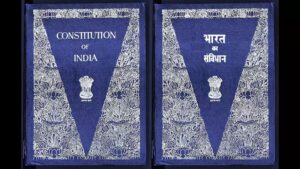India, Bharat and a host of implications.
Relevance
- GS 3: Science and Technology- Developments and their Applications and Effects in Everyday Life.
- Tags: #ArtemisAccords #OuterSpaceTreaty#IndianExpressEditorialAnalysis #GS3 #IE.
Why in the news?
Recently the unprecedented use of ‘President of Bharat’ instead of ‘President of India’ (as seen in an invitation card by the President to the heads of States and governments and Chief Ministers for an official banquet on the occasion of the G-20 summit) is on account of the Narendra Modi government’s concern that ‘INDIA’ may become politically potent.
Historical Aspect
- A brief look at the controversy raised by the Muslim League over the name India in 1947 would be in order.
- The transfer of power from the British to Indian hands in 1947 was through the British Parliament’s Indian Independence Act of 1947.
- It created two dominions — India and Pakistan — and released the Princely States from British paramountcy, thereby, technically making them independent and sovereign.
- At the same time, the British advised the Princely states to join one of the two dominions. Most did so before August 15, 1947. Thus, two dominions came into being in what was British India and the Princely states in the sub-continent.
- Pakistani leaders favored that India should be named either Hindustan or Bharat.
- They argued that two ‘successor’ states had emerged from the dissolution of the British Indian empire:
- Pakistan and Hindustan or Bharat. India’s position was that it was the successor state to British India, in terms of international law, and that Pakistan had seceded from India.
- Hence, while India retained its international personality, including its membership of the United Nations (UN), Pakistan, as a new state created through secession, would have to take steps to acquire an international personality.
- The matter was finally decided in India’s favor, and Pakistan was compelled to take steps to establish its international status, including applying for membership of the UN, which, incidentally, Afghanistan opposed. India retained the name ‘India’ in all international and multilateral forums.
- Thus, the country’s international personality was and continues to be denoted by the word India. Generally, whenever the English language is used in international, multilateral, or bilateral settings, the word India is used.
- Thus, in Hindi, Bharat is used while in English it is India.
Under the 58th Amendment
- For an authoritative background of the English and Hindi versions, it is best to turn to the 58th Amendment of the Constitution done in 1987.
- Its ‘Statement of Objects and Reasons’ mentions that “The Constitution of India was adopted by the Constituent Assembly in English.
- A Hindi translation of the Constitution, signed by the members of the Constituent Assembly, was also published in 1950 under the authority of the President of the Constituent Assembly in accordance with a resolution adopted by that Assembly”.
- The 58th Amendment empowered the President to publish under his authority the authoritative text ‘in the Hindi language’ of the Constitution which could be used in the legal process too.
- Thus, the Hindi text of the Constitution published by the government following the amendment is ‘authoritative’.
Constitutionally the validation
- The English language version of the Constitution is entitled “Constitution of India’ Its Article 1(1) is “India, that is Bharat, shall be a Union of States”. The primacy in this formulation is given to the word India.
- The Hindi version is titled ‘Bharat ka Samvidhan’. Article 1(1) in the Hindi version reads “Bharat artharth India, rajyon ka sangh hoga”. The word “artharth” means “that is”.
- Clearly, in the Hindi version, primacy is given to the word Bharat. The logic of the formulations has led to the practice of using the word India in the English language and Bharat in Hindi. That practice has prevailed in internal documents as well as international documents which are generally in English.
- Thus, the Gazette published in English is called the ‘Gazette of India’, and in Hindi it is ‘Bharat ka Rajpatra’.
Conclusion
- It is clear that the Sangh Parivar and the Narendra Modi government wish to use the word, Bharat. Their preference for Bharat instead of the word India is clear.
- There are historical, ideological, constitutional, and international implications associated with the words Bharat and India.
- The use of the formulation ‘President of Bharat’ in the G-20 invitation is a giveaway.
- They may also begin to use ‘Bharat’ in the English language in the government’s internal documents.
- The problem is that they cannot do so internationally unless they officially change the country’s name to Bharat and drop India.
- By doing so, they may alienate parts of the country which prefer India to Bharat.
- In any event, the tradition of using India in English and Bharat in Hindi is wise and constitutionally correct.
Source: The Hindu.
Mains Question.
Discuss various positives and challenges in using the Bharat instead of India.




